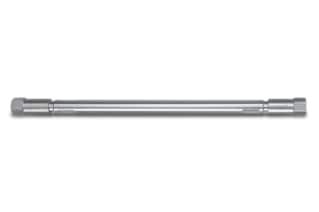
|
Chemistry |
C18 |
|
Separation Mode |
Reversed Phase |
|
Particle Substrate |
Silica |
|
pH Range Min |
2 pH |
|
pH Range Max |
8 pH |
|
Maximum Pressure |
6000 psi (415 Bar) |
|
Endcapped |
Yes |
|
Silanol Activity |
Low |
|
Particle Shape |
Spherical |
|
Particle Size |
3.5 µm |
|
Endfitting Type |
Waters |
|
Pore Size |
100 Å |
|
Format |
Method Validation Kit |
|
Surface Area |
335 |
|
System |
HPLC |
|
Particle Technology |
Silica |
|
USP Classification |
L1 |
|
Inner Diameter |
4.6 mm |
|
Length |
150 mm |
|
Carbon Load |
19 % |
|
UNSPSC |
41115709 |
|
Brand |
Symmetry |
|
Product Type |
Column Kits |
|
Units per Package |
3 pk |

Symmetry Silica C18 Method Validation Kit, 100Å, 3.5 µm, 4.6 mm X 150 mm, 3/pk
The Symmetry Silica C18 Method Validation Kit allows you to obtain good consistency in chromatographic findings and comprises three Symmetry C18 columns loaded with separate batches of sorbent. One of the narrowest ligand surface coverage (ligand density) specifications in the market are found in the Symmetry C18 Column, which produces minimal variations in resolution and repeatable batch-to-batch results. You achieve great repeatability year after year in your lab with the Symmetry C18 Columns from the Validation kit.
As the Symmetry C18 Column doesn't need to be revalidated and you won't have to design new techniques with each batch of new columns, you will avoid the labor and lab expenditures that build up with typical analytical columns that need ongoing monitoring and QC testing.
The Symmetry C18 Columns were created by Waters using high purity raw materials and column packaging techniques, making them among the most repeatable HPLC columns. Additionally, a three-page Certificate of Analysis that lists the specifications and the outcomes of 22 crucial tests that each column must pass before being certified as quality is included with each shipment of the Symmetry C18 Column.
The Symmetry C18 Columns are produced in specially designated Waters facilities that are cGMP, ISO9001, and ISO13485 certified, where the strictest conditions are guaranteed, and each step of the manufacturing process is meticulously controlled. This makes it possible to produce Symmetry C18 Columns with the strictest market criteria, ensuring reliable results each and every time. You can browse through our catalog or review our website to shop for lab equipment to meet all your laboratory requirements.
You may also want to review the Reversed-Phase QC Reference Material, as it is a special assortment of standards and mixes. Before analyzing crucial material, these items enable the user to assess and benchmark their chromatography equipment. Given that it comprises components that might be difficult to separate, the Reversed-Phase QC Reference Material is a very complicated reference material mixture. It is appropriate when doing difficult assays on a regular basis because it is intended to give this complexity.
What Is The Process For Column Equilibration For The Symmetry C18 Column?
Before column equilibration can be performed, it is important to ensure mobile phase compatibility before changing to another mobile phase system. Equilibrate the column with a minimum of 10 column volumes of the mobile phase to be used. To avoid precipitating out mobile phase buffers on your column or in the system, flush the column with five column volumes of a water/organic solvent mixture, using the same or lower solvent content as in the desired buffered mobile phase.